Tennis theme by Rasenki
Download: Tennis.p3t
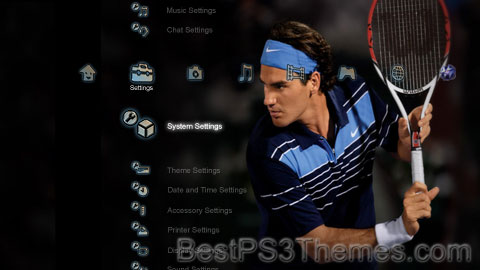
(9 backgrounds)
 French singles player Guillaume Rufin serves to Czech player Tomáš Berdych in a tennis match at the 2013 Australian Open | |
| Highest governing body | International Tennis Federation |
|---|---|
| First played | 19th century, Birmingham, England, United Kingdom |
| Characteristics | |
| Contact | No |
| Team members | Singles or doubles |
| Mixed-sex | Yes, separate tours and mixed doubles |
| Type | Outdoor or indoor |
| Equipment | Ball, racket, net |
| Venue | Tennis court |
| Glossary | Glossary of tennis terms |
| Presence | |
| Country or region | Worldwide |
| Olympic | Part of Summer Olympic programme from 1896 to 1924 Demonstration sport in the 1968 and 1984 Summer Olympics Part of Summer Olympic programme since 1988 |
| Paralympic | Part of Summer Paralympic programme since 1992 |
Tennis is a racket sport that is played either individually against a single opponent (singles) or between two teams of two players each (doubles). Each player uses a tennis racket that is strung with cord to strike a hollow rubber ball covered with felt over or around a net and into the opponent's court. The object of the game is to manoeuvre the ball in such a way that the opponent is not able to play a valid return. The player who is unable to return the ball validly will not gain a point, while the opposite player will.[1][2]
Tennis is an Olympic sport and is played at all levels of society and at all ages. The sport can be played by anyone who can hold a racket, including wheelchair users. The original forms of tennis developed in France during the late Middle Ages.[3] The modern form of tennis originated in Birmingham, England, in the late 19th century as lawn tennis.[4] It had close connections both to various field (lawn) games such as croquet and bowls as well as to the older racket sport today called real tennis.[5]
The rules of modern tennis have changed little since the 1890s. Two exceptions are that until 1961 the server had to keep one foot on the ground at all times,[6][7] and the adoption of the tiebreak in the 1970s.[8] A recent addition to professional tennis has been the adoption of electronic review technology coupled with a point-challenge system, which allows a player to contest the line call of a point, a system known as Hawk-Eye.[9][10]
Tennis is played by millions of recreational players and is a popular worldwide spectator sport.[11] The four Grand Slam tournaments (also referred to as the majors) are especially popular: the Australian Open, played on hardcourts; the French Open, played on red clay courts; Wimbledon, played on grass courts; and the US Open, also played on hardcourts.[12]
History[edit]
Predecessors[edit]
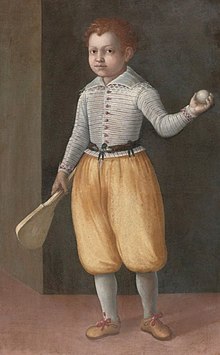

Historians believe that the game's ancient origin lay in 12th-century northern France, where a ball was struck with the palm of the hand.[13] Louis X of France was a keen player of jeu de paume ("game of the palm"), which evolved into real tennis, and became notable as the first person to construct indoor tennis courts in the modern style. Louis was unhappy with playing tennis outdoors and accordingly had indoor, enclosed courts made in Paris "around the end of the 13th century".[14] In due course this design spread across royal palaces all over Europe.[14] In June 1316 at Vincennes, Val-de-Marne, and following a particularly exhausting game, Louis drank a large quantity of cooled wine and subsequently died of either pneumonia or pleurisy, although there was also suspicion of poisoning.[15] Because of the contemporary accounts of his death, Louis X is history's first tennis player known by name.[15] Another of the early enthusiasts of the game was King Charles V of France, who had a court set up at the Louvre Palace.[16]
It was not until the 16th century that rackets came into use and the game began to be called "tennis", from the French term tenez, which can be translated as "hold!", "receive!" or "take!", an interjection used as a call from the server to his opponent.[17] It was popular in England and France, although the game was only played indoors, where the ball could be hit off the wall. Henry VIII of England was a big fan of this game, which is now known as real tennis.[18]
An epitaph in St Michael's Church, Coventry, written c. 1705, read, in part:[19]
Here lyes an old toss'd Tennis Ball:
Was racketted, from spring to fall,
With so much heat and so much hast,
Time's arm for shame grew tyred at last.
During the 18th and early 19th centuries, as real tennis declined, new racket sports emerged in England.[20]
The invention of the first lawn mower in Britain in 1830 is believed to have been a catalyst for the preparation of modern-style grass courts, sporting ovals, playing fields, pitches, greens, etc. This in turn led to the codification of modern rules for many sports, including lawn tennis, most football codes, lawn bowls and others.[21]
Origins of the modern game[edit]
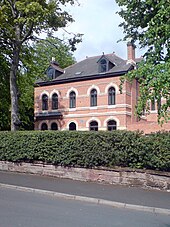
Between 1859 and 1865, Harry Gem, a solicitor, and his friend Augurio Perera developed a game that combined elements of racquets and the Basque ball game pelota, which they played on Perera's croquet lawn in Birmingham, England.[22][23] In 1872, along with two local doctors, they founded the world's first tennis club on Avenue Road, Leamington Spa.[24] This is where "lawn tennis" was used as the name of an activity by a club for the first time.
In Tennis: A Cultural History, Heiner Gillmeister reveals that on 8 December 1874, British army officer Walter Clopton Wingfield wrote to Harry Gem, commenting that he (Wingfield) had been experimenting with his version of lawn tennis "for a year and a half".[25] In December 1873, Wingfield designed and patented a game which he called sphairistikè (Greek: σφαιριστική, meaning "ball-playing"), and which was soon known simply as "sticky" – for the amusement of guests at a garden party on his friend's estate of Nantclwyd Hall, in Llanelidan, Wales.[26] According to R. D. C. Evans, turfgrass agronomist, "Sports historians all agree that [Wingfield] deserves much of the credit for the development of modern tennis."[20][27] According to Honor Godfrey, museum curator at Wimbledon, Wingfield "popularized this game enormously. He produced a boxed set which included a net, poles, rackets, balls for playing the game – and most importantly you had his rules. He was absolutely terrific at marketing and he sent his game all over the world. He had very good connections with the clergy, the law profession, and the aristocracy and he sent thousands of sets out in the first year or so, in 1874."[28] The world's oldest annual tennis tournament took place at Leamington Lawn Tennis Club in Birmingham in 1874.[29] This was three years before the All England Lawn Tennis and Croquet Club would hold its first championships at Wimbledon, in 1877. The first Championships culminated in a significant debate on how to standardise the rules.[28]
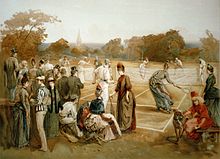
In the United States in 1874, Mary Ewing Outerbridge, a young socialite, returned from Bermuda with a sphairistikè set. She became fascinated by the game of tennis after watching British army officers play.[30] She laid out a tennis court at the Staten Island Cricket Club at Camp Washington, Tompkinsville, Staten Island, New York. The first American National championship was played there in September 1880. An Englishman named O.E. Woodhouse won the singles title, and a silver cup worth $100, by defeating Canadian I. F. Hellmuth.[31] There was also a doubles match which was won by a local pair. There were different rules at each club. The ball in Boston was larger than the one normally used in New York.
On 21 May 1881, the oldest nationwide tennis organization in the world[32] was formed, the United States National Lawn Tennis Association (now the United States Tennis Association) in order to standardize the rules and organize competitions.[33] The US National Men's Singles Championship, now the US Open, was first held in 1881 at the Newport Casino, Newport, Rhode Island.[34] The US National Women's Singles Championships were first held in 1887 in Philadelphia.[35]

Tennis also became popular in France, where the French Championships date to 1891, although until 1925 they were open only to tennis players who were members of French clubs.[36] Thus, Wimbledon, the US Open, the French Open and the Australian Open (dating to 1905) became and have remained the most prestigious events in tennis.[37][38] Together, these four events are called the Majors or Slams (a term borrowed from bridge rather than baseball).[39]
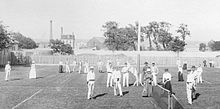
In 1913, the International Lawn Tennis Federation (ILTF), now the International Tennis Federation (ITF), was founded and established three official tournaments as the major championships of the day. The World Grass Court Championships were awarded to Great Britain. The World Hard Court Championships were awarded to France; the term "hard court" was used for clay courts at the time. Some tournaments were held in Belgium instead. And the World Covered Court Championships for indoor courts were awarded annually; Sweden, France, Great Britain, Denmark, Switzerland and Spain each hosted the tournament.[40] At a meeting held on 16 March 1923 in Paris, the title "World Championship" was dropped and a new category of "Official Championship" was created for events in Great Britain, France, the US and Australia [41] – today's Grand Slam events.[40][42] The impact on the four recipient nations to replace the "world championships" with "official championships" was simple in a general sense: each became a major nation of the federation with enhanced voting power, and each now operated a major event.[40]
The comprehensive rules promulgated in 1924 by the ILTF have remained largely stable in the ensuing 80 years, the one major change being the addition of the tiebreak system designed by Jimmy Van Alen.[43] That same year, tennis withdrew from the Olympics after the 1924 Games, but returned 60 years later as a 21-and-under demonstration event in 1984. This reinstatement was credited by the efforts of then ITF president Philippe Chatrier, ITF general secretary David Gray and ITF vice president Pablo Llorens, with support from International Olympic Committee president Juan Antonio Samaranch. The success of the event was overwhelming, and the IOC decided to reintroduce tennis as a full-medal sport at Seoul in 1988.[44][45]

The Davis Cup, an annual competition between men's national teams, dates to 1900.[46] The analogous competition for women's national teams, the Fed Cup, was founded as the Federation Cup in 1963 to celebrate the 50th anniversary of the founding of the ITF.[47]
In 1926, promoter C. C. Pyle established the first professional tennis tour with a group of American and French tennis players playing exhibition matches to paying audiences.[38][48] The most notable of these early professionals were the American Vinnie Richards and the Frenchwoman Suzanne Lenglen.[38][49] Players turned pro would no longer be permitted to compete in the major (amateur) tournaments.[38]
In 1968, commercial pressures and rumours of some amateurs taking money under the table led to the abandonment of this distinction, inaugurating the Open Era, in which all players could compete in all tournaments, and top players were able to make their living from tennis.[50] With the beginning of the Open Era, the establishment of an international professional tennis circuit, and revenues from the sale of television rights, tennis's popularity has spread worldwide, and the sport has shed its middle-class English-speaking image[51] (although it is acknowledged that this stereotype still exists).[51][52]
In 1954, Van Alen founded the International Tennis Hall of Fame, a nonprofit museum in Newport, Rhode Island.[53] The building contains a large collection of tennis memorabilia as well as a hall of fame honouring prominent members and tennis players from all over the world.[54]
Equipment[edit]
Part of the appeal of tennis stems from the simplicity of equipment required for play. Beginners need only a racket and balls.[1]

Rackets[edit]

The components of a tennis racket include a handle, known as the grip, connected to a neck which joins a roughly elliptical frame that holds a matrix of tightly pulled strings. For the first 100 years of the modern game, rackets were made of wood and of standard size, and strings were of animal gut. Laminated wood construction yielded more strength in rackets used through most of the 20th century until first metal and then composites of carbon graphite, ceramics, and lighter metals such as titanium were introduced. These stronger materials enabled the production of oversized rackets that yielded yet more power. Meanwhile, technology led to the use of synthetic strings that match the feel of gut yet with added durability.
Under modern rules of tennis, the rackets must adhere to the following guidelines;[55]
- The hitting area, composed of the strings, must be flat and generally uniform.
- The frame of the hitting area may not be more than 29 inches (74 cm) in length and 12.5 inches (32 cm) in width.
- The entire racket must be of a fixed shape, size, weight, and weight distribution. There may not be any energy source built into the rackets.
- The rackets must not provide any kind of communication, instruction or advice to the player during the match.
The rules regarding rackets have changed over time, as material and engineering advances have been made. For example, the maximum length of the frame had been 32 inches (81 cm) until 1997, when it was shortened to 29 inches (74 cm).[56]
Many companies manufacture and distribute tennis rackets. Wilson, Head and Babolat are three of the most commonly used brands; however, many more companies exist.[57] The same companies sponsor players to use these rackets in the hopes that the company name will become better known by the public.
Strings[edit]
There are multiple types of tennis strings, including natural gut and synthetic stings made from materials such as nylon, kevlar, or polyester.[58]

Natural gut[edit]
The first type of tennis strings available were natural gut strings, introduced by Babolat. They were the only type used until synthetic strings were introduced in the 1950s. Natural gut strings are still used frequently by players such as Roger Federer. They are made from cow intestines, and provide increased power, and are easier on the arm than most strings.[59]
Synthetic[edit]
Most synthetic strings are made from monofilament or multifiliament nylon strings. Monofilament strings are cheap to buy, and are used widely by many recreational level players for their all round performance, while multifilament strings are created to mimic natural gut more closely by weaving together fibres, but are generally more expensive than their monofilament counterparts.[58] Polyester strings allow for more spin on the ball than any other string, due to their firm strings, while keeping control of the ball, and this is why many players use them, especially higher player ones.[60] Kevlar tennis strings are highly durable, and are mostly used by players that frequently break strings, because they maintain tension well, but these strings can be stiff on the arm.[61]
Hybrid strings[edit]
Hybrid stringing is when a tennis racket is strung with two different strings for the mains (the vertical strings) and the crosses (the horizontal strings). This is most commonly done with two different strings that are made of different materials, but can also be done with two different types of the same string. A notable example of a player using hybrid strings is Roger Federer, using natural gut strings in his mains and polyester strings in his crosses.[62]
Balls[edit]

Tennis balls were originally made of cloth strips stitched together with thread and stuffed with feathers.[63] Modern tennis balls are made of hollow vulcanized rubber with a felt coating. Traditionally white, the predominant colour was gradually changed to optic yellow in the latter part of the 20th century to allow for improved visibility. Tennis balls must conform to certain criteria for size, weight, deformation, and bounce to be approved for regulation play. The International Tennis Federation (ITF) defines the official diameter as 65.41–68.58 mm (2.575–2.700 in). Balls must weigh between 56.0 and 59.4 g (1.98 and 2.10 oz).[64] Tennis balls were traditionally manufactured in the United States and Europe. Although the process of producing the balls has remained virtually unchanged for the past 100 years, the majority of manufacturing now takes place in the Far East. The relocation is due to cheaper labour costs and materials in the region.[65] Tournaments that are played under the ITF Rules of Tennis must use balls that are approved by the International Tennis Federation (ITF) and be named on the official ITF list of approved tennis balls.[66]
Manner of play[edit]
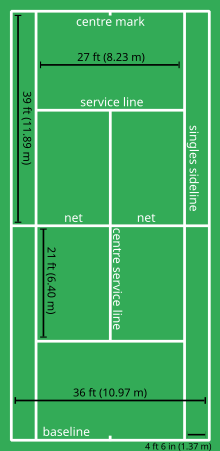
Court[edit]
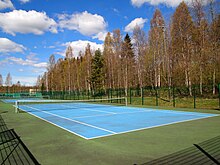
Tennis is played on a rectangular, flat surface. The court is 78 feet (23.77 m) long, and 27 feet (8.2 m) wide for singles matches and 36 ft (11 m) for doubles matches.[67] Additional clear space around the court is required in order for players to reach overrun balls. A net is stretched across the full width of the court, parallel with the baselines, dividing it into two equal ends. It is held up by either a cord or metal cable of diameter no greater than 0.8 cm (1⁄3 in).[66] The net is 3 feet 6 inches (1.07 m) high at the posts and 3 feet (0.91 m) high in the centre.[67] The net posts are 3 feet (0.91 m) outside the doubles court on each side or, for a singles net, 3 feet (0.91 m) outside the singles court on each side.
The modern tennis court owes its design to Major Walter Clopton Wingfield. In 1873, Wingfield patented a court much the same as the current one for his stické tennis (sphairistike). This template was modified in 1875 to the court design that exists today, with markings similar to Wingfield's version, but with the hourglass shape of his court changed to a rectangle.[68]
Tennis is unusual in that it is played on a variety of surfaces.[69] Grass, clay, and hard courts of concrete or asphalt topped with acrylic are the most common. Occasionally carpet is used for indoor play, with hardwood flooring having been historically used. Artificial turf courts can also be found.
Lines[edit]
The lines that delineate the width of the court are called the baseline (farthest back) and the service line (middle of the court). The short mark in the centre of each baseline is referred to as either the hash mark or the centre mark. The outermost lines that make up the length are called the doubles sidelines; they are the boundaries for doubles matches. The lines to the inside of the doubles sidelines are the singles sidelines, and are the boundaries in singles play. The area between a doubles sideline and the nearest singles sideline is called the doubles alley, playable in doubles play. The line that runs across the centre of a player's side of the court is called the service line because the serve must be delivered into the area between the service line and the net on the receiving side. Despite its name, this is not where a player legally stands when making a serve.[70]
The line dividing the service line in two is called the centre line or centre service line. The boxes this centre line creates are called the service boxes; depending on a player's position, they have to hit the ball into one of these when serving.[71] A ball is out only if none of it has hit the area inside the lines, or the line, upon its first bounce. All lines are required to be between 1 and 2 inches (25 and 51 mm) in width, with the exception of the baseline which can be up to 4 inches (100 mm) wide, although in practice it is often the same width as the others.[70]
